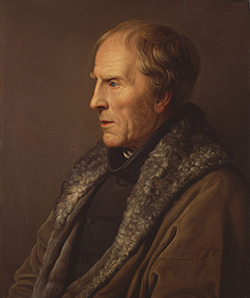
By Sam Ben-Meir


NEW YORK — Caspar David Friedrich is among those great painters the appreciation of whom has ironically suffered through the overexposure of a handful of paintings that has led to a general neglect of a magnificent and largely overlooked body of work.
The foremost representative of early German Romantic painting, Friedrich is thankfully receiving renewed attention at New York’s Metropolitan Museum of Art, where the public can acquaint itself not only with such well known works as Wanderer Above the Sea of Fog and Two Men Contemplating the Moon, but lesser-known works that are no less extraordinary.
Friedrich is a very accessible painter, which helps to explain the ease with which he has been appropriated and just as often dismissed as irrelevant or worse. The remedy to this unfortunate situation is twofold: one, to refocus our attention on works that have not been reproduced ad nauseam – to rediscover the artist through an entrance not overly trodden, and at the same time to see his work in the light of the philosophical ideas and theories that surrounded and influenced him, rather than through the worst depredations of early 20th century German politics that are unfairly traced back to the early German Romantics.
A great artist or thinker can be appropriated for good or ill, he or she can be reinterpreted, misinterpreted, reconstructed or deconstructed. To hold them responsible for the crimes committed by those they could know nothing of – let alone anticipate – seems a distinctly unproductive and even irresponsible way of assessing their contributions to humanity.
There are marvelous surprises in store for those attending this retrospective with open and unjaded eyes: paintings of uncanny wonderment, suffused with a sense of the sublime, and expressing a philosophy of nature that has much to say about today if we care to listen.
It is nature, and our place in it that is the overarching theme of Friedrich’s work, that to which he tirelessly returns. It is rare to find philosophers such as GWF Hegel and Friedrich Schelling invoked in an art exhibition – but their names are deservedly mentioned in the context of Friedrich’s painting, even if the curators could hardly begin to explain their relevance.
Both Schelling and Hegel contributed to Naturphilosophie, that is, the philosophy of nature. It is gaining renewed attention – perhaps in part because we are living at a time of unprecedented environmental devastation and the concept of nature that we find in Schelling and Hegel contains untapped resources with which to counter the overly reductionistic, exploitative, and instrumentalist approach to the natural world that prevails today.
Friedrich expresses in his work a philosophy of nature that is arguably indispensable to us today if we are to confront environmental degradation with something other than shock and despair. Cross in the Mountains (1812) is among the many paintings that feature a cross (or in the case a crucifix) submerged in a rugged, rocky landscape. Large evergreens loom in the background (in sharp contrast to the dying foliage we find in the foreground) while flanking the trees soars a church facade, perhaps the famous Marienkirche in Neubrandenburg. Friedrich is intent on establishing a kinship between the fir trees and the church, which one might associate with the notion of nature as God’s cathedral – or better, perhaps, with nature as theophany, an appearance of the divine itself.
In Friedrich’s Cross by the Baltic Sea (1815), the cross is set atop a large outcropping with a massive anchor in the foreground. With wispy clouds drifting before it, a full moon hovers above the horizon, bathing the scene in its otherworldly glow. The cross set amidst a mountainous landscape was among Friedrich’s recurring motifs, and one that the much of the public viewed as somewhat scandalous. It brought together nature and spirit in a way that was unfamiliar and suggestive of an attitude towards the natural world that resonated with early romanticism but ran counter to the traditional subjugation of nature to the spiritual world beyond, from which this world derived whatever meaning or significance it enjoyed.
In numerous paintings, Friedrich returns to the theme of a figure seen from behind as he or she contemplates some form of landscape – not only in such famous works as Wanderer Above the Sea of Fog (1818), and Two Men Contemplating the Moon (1825-30), but also for example, Woman Before the Rising or Setting Sun (1818), and Woman at the Window (1822), among others.
The paintings take meditation on nature to the second order: we are invited to contemplate individuals who themselves are immersed in nature’s sublimity. This is crucial to understanding Friedrich’s conception of nature. It is indeed divine and yet is not complete without us: self-consciousness, spirit or Geist completes nature and elevates it to true divinity. Friedrich does precisely what philosophy must do: that is, ‘explore how nature philosophizes, and how thinking nature is impossible without a concept of nature as thinking through us.’
Schelling, Hegel and Goethe (who also had a direct influence on Friedrich) were all enamored with the philosophy of Spinoza, for whom Nature and God were interchangeable terms: there was nothing beyond the single, infinite, rational and divine totality which he refers to as Natura sive Deus (Nature or God), the one infinite yet intelligible Substance of which we and everything we perceive were mere modifications.
Yet, Schelling and Hegel had also bathed in the critical philosophy of Kant which recognized the role of the rational subject in constituting the known, the role of reason in providing the necessary conditions of knowledge and experience. The mighty task for post-Kantian German Idealists, including Schelling and Hegel, was how to bridge the philosophies of Spinoza and Kant, thinkers who were in fundamental ways diametrically opposed. Kant’s critical philosophy excluded the possibility of any theoretical knowledge pertaining to God, the Absolute, or ultimate reality, the highest objects of traditional metaphysics, of which Spinoza was perhaps the greatest representative. What Friedrich does in his painting is construct through art that bridge that Schelling and Hegel sought to achieve through philosophical speculation.
Human consciousness has a role in lifting nature up: one might even say that God needs us to become fully divine. Nature may be divine, but it is not static, it is constantly changing and ultimately arrives at self-awareness through us. This is the implication of so much that Friedrich produced. Consider, for example, his Monk Standing Beside the Sea (1808-10): the sparse canvas is among the masterpieces included in the exhibition, haunting in its ingenious minimalism.
Originally, Friedrich included several ships on the sea, but in a stroke of brilliance he removed them so that we are left with a sole figure, a monk – a symbol of spiritual awareness – as he stands before the empty vastness of the sea. It is an intoxicating work, mesmerizing and hypnotic in its vision of our insignificance in relation to the inconceivable vastness of space and time on the one hand, and our indispensability to the universe’s self-knowledge on the other.
The exhibition concludes with late works that reveal the artist brooding on death and transcendence. Among the most memorable of these is A Walk at Dusk (1830-35), where again we find a lone figure – probably the artist himself – standing, head bowed, before a dolmen, or ancient grave marker, an uncanny rocky formation consisting of a large boulder resting improbably enough atop much smaller stones.
On numerous occasions Friedrich depicted, and memorialized, these ancient sites which were disappearing in the artist’s own day. It is a fitting end to the exhibition, bringing together motifs that occupied Friedrich through the years: the moonlight at nightfall, the autumnal landscape, the dolmen; and also, though scarcely visible, the evening star – that is, the planet Venus, a symbol of rebirth, hope and guidance, and the transition from one phase of life or being to another. The painting becomes not simply a meditation on death, but on transformation, rebirth, and memory, a poetic and solemn refrain to a rare and wondrous exhibition.
*
Sam Ben-Meir is a professor of philosophy and world religions at Mercy College in New York City.